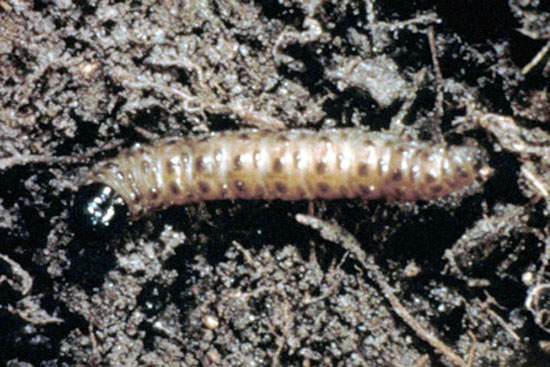Issue 10, July 2, 2018
Sod Webworm
Sod webworms are a group of grass-feeding larvae that can cause brown patches in the turf which could eventually cover large sections of a lawn. Brown patches in the turf develop as larvae chew grass blades off near the crown of individual grass plants. The larvae can also attract insect-feeding birds like brown-headed cowbirds, red-winged blackbirds, robins and starlings that can cause additional damage as they probe the thatch for larvae.
Hot, dry weather typically allows sod webworm larvae to thrive and cause more damage. In contrast, the wet conditions we have been experiencing throughout Illinois may encourage biological control agents, like microsporidia, that control this pest naturally and limit their impact. With the presence of these natural controls, some areas may not require any treatment.
Scout for sod webworms in locations where brown patches do not recover with watering or locations that more insect-feeding birds are visiting.
There are two ways to scout for sod webworm larvae. The first is to search for the larvae in the turf. The larvae are drab, they can be tan, white, grey or green, and grow about 1 inch in length. They create silk-lined burrows in the thatch, where they reside during the day, then emerge at night to feed. Scout injured areas by parting the grass with your hands and looking for the larvae or small green pellets of frass (insect droppings).
The second method is to flush the larvae out of the turf. Mix a bucket of soapy water (1 tbsp dish soap and 1 gal water) and apply it evenly across 1 sq ft of turf. The soap will irritate the larvae and they will move to the surface where they can be identified (this may take 10 – 15 min). If you find 2 – 3 larvae per sq ft of turf, you can treat for these insects.

Sod webworm larva.
When treatment is warranted, chemical and biological treatments can be effective in controlling larval populations. Effective organic biological controls include spinosad (Conserve), a bacterial control agent, or Steinernema carpocapsae (Biosafe), an entomopathogenic nematode.
Effective chemical controls include bifenthrin (Onyx, Talstar), carbaryl (Sevin), chlorantroniliprole (Acelepryn), clothianidin (Arena), deltamethrin (Delta Gard), indoxacarb (Provaunt), lambda-cyhalothrin (Scimitar) and trichlorfon (Dylox). Some of these products are available in granular formulations which eliminates the risk of drift on to nearby flowering plants. It is important to avoid applying neonicotinoid insecticides to lawns that have a mix of turfgrass and clover, to protect the bees and other pollinators that visit the flowers. (Sarah Hughson)
Author:
Sarah Hughson